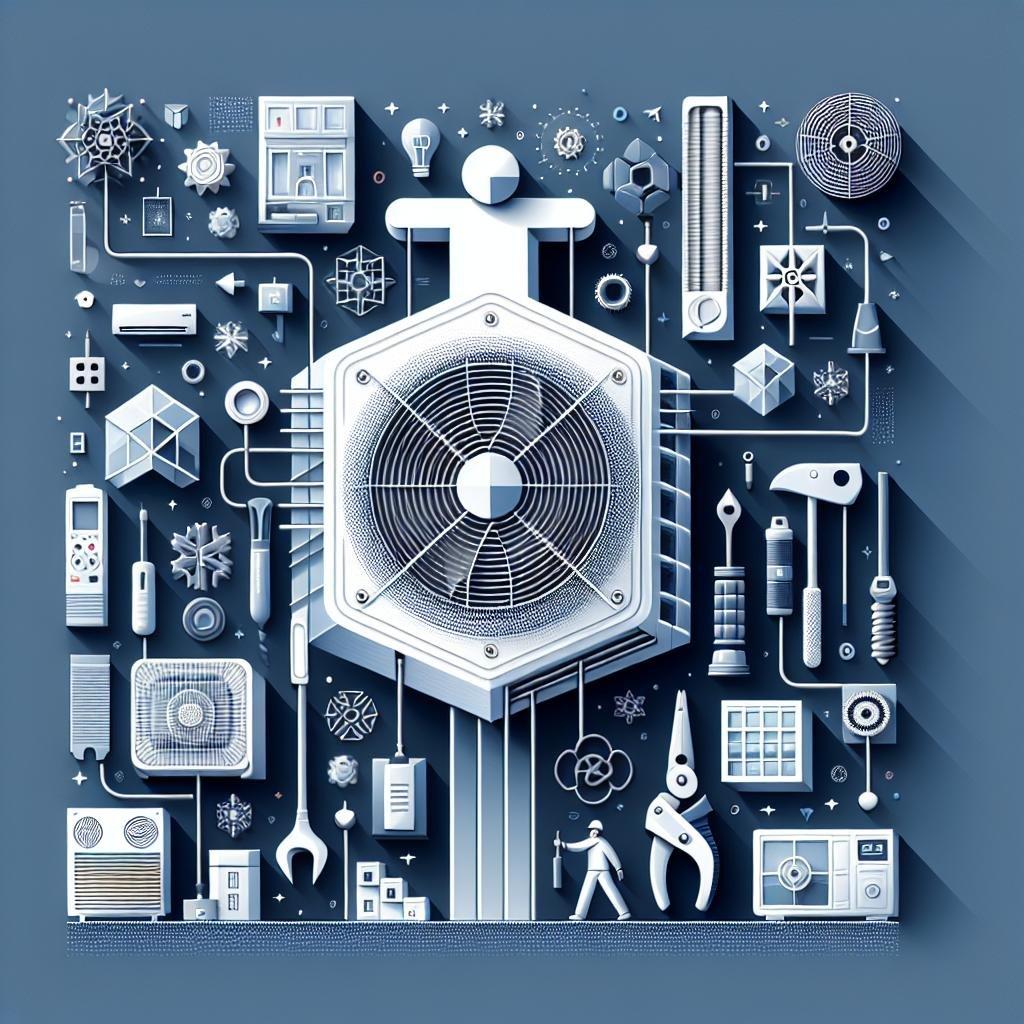Essential Tips for Properly Inspecting and Maintaining Mini Split AC Systems in Commercial Properties
In the bustling landscape of modern commercial properties, where comfort and productivity hinge on climate control, mini split air conditioning systems have emerged as a favored solution for their efficiency and versatility. Though, like any vital component of a well-functioning habitat, these systems require diligent inspection and maintenance to operate at peak performance. Neglecting this crucial aspect can lead to unforeseen breakdowns, inflated energy bills, and compromised air quality—all factors that can disrupt business operations and impact tenant satisfaction. In this article, we will explore essential tips for properly inspecting and maintaining your mini split AC systems, ensuring that your property remains a comfortable haven for employees and clients alike. By fostering a proactive approach to maintenance, you can safeguard your investment, enhance system longevity, and maintain an inviting atmosphere where productivity can thrive.
Understanding the Anatomy of Mini Split AC Systems for Effective Maintenance
To effectively maintain mini split AC systems, it’s crucial to grasp their anatomy. At the heart of these systems are two main components: the indoor unit and the outdoor unit. The indoor unit is responsible for cooling and distributing air within the room, equipped with an evaporator coil, a fan, and an air filter. On the other hand, the outdoor unit houses the compressor and the condenser coil, wich work in tandem to dissipate heat from the refrigerant. Understanding how these components interact not only aids in troubleshooting potential issues but also enhances the overall maintenance process.
Regular inspections of both the indoor and outdoor units are essential for optimal performance. Here are some key aspects to focus on during your maintenance routine:
- Clean the air filters regularly to improve airflow and efficiency.
- Inspect the refrigerant lines for any signs of wear or damage.
- Check the drainage system to prevent clogs and water damage.
- Ensure the outdoor unit is clear from debris like leaves and branches.
By routinely assessing these elements, you can significantly extend the lifespan of the system and ensure a comfortable environment for occupants.
| component | Function | Maintenance Tip |
|---|---|---|
| Indoor Unit | Cools and circulates air | Change air filters monthly |
| Outdoor Unit | Dissipates heat | Clear debris every season |
| refrigerant lines | Transport refrigerant | Inspect for leaks regularly |
| Drainage System | Removes excess moisture | Check for clogs monthly |

Seasonal Inspection Strategies to Enhance Efficiency and Longevity
Implementing a proactive inspection strategy tailored to seasonal transitions can significantly boost the performance of mini split AC systems in commercial properties. Begin by scheduling inspections at the start of each season to address specific challenges that temperature changes may introduce. During these inspections,focus on the following aspects:
- Cleaning filters: Dirty filters can hinder airflow,hampering the system’s efficiency. Ensure that filters are cleaned or replaced regularly.
- Checking refrigerant levels: Low refrigerant can affect cooling efficacy. Verify and adjust levels as necessary.
- Inspecting drainage: Clear any blockages in the condensate drain line to prevent water damage and improve efficiency.
In addition to these routine checks, consider utilizing a detailed checklist to document inspection findings. This practice can definitely help identify recurring issues and allow for targeted maintenance over time. Consider this simple table to track your seasonal inspection goals:
| Task | Frequency | Status |
|---|---|---|
| Clean filters | Monthly | ✔️ |
| Check refrigerant levels | Seasonal | ✔️ |
| Inspect drain lines | Quarterly | ❌ |
By maintaining a meticulous approach to inspections and documentation, property managers can ensure their mini split AC systems operate efficiently and extend their lifespan, ultimately leading to lower operational costs and improved tenant satisfaction.

Common Issues and Troubleshooting Tips for Commercial Mini Splits
When it comes to the functionality of commercial mini splits, several common issues may arise, affecting performance and efficiency. Inconsistent Cooling is a frequent complaint, often stemming from blocked air filters or inadequate refrigerant levels. Inspecting the air filters regularly and replacing them as needed can significantly enhance airflow. Additionally, Unusual Noises such as rattling, squeaking, or buzzing can indicate loose components or debris within the unit. It’s essential to conduct regular inspections and tighten any loose parts to mitigate this issue.
Another issue that may surface is Condensate Drain Problems, which can lead to water leakage and potential property damage. Regularly checking the drain line for clogs is crucial. A preventive strategy includes flushing the drain line with a mixture of vinegar and water periodically. Furthermore, Thermostat Malfunctions can disrupt comfort levels. Ensure that the thermostat is calibrated correctly and that it’s positioned away from heat sources or direct sunlight. Below is a troubleshooting table that summarizes these common issues and the recommended actions:
| Issue | Possible Cause | Recommended action |
|---|---|---|
| inconsistent Cooling | Blocked Air filters | Check and replace air filters |
| Unusual Noises | Loose components | Tighten loose parts and remove debris |
| condensate Drain Problems | Clogs in Drain Line | Flush drain line with vinegar solution |
| Thermostat Malfunctions | Improper Calibration | recalibrate and reposition thermostat |

Best Practices for Cleaning and Servicing Mini Split Units Regularly
Cleaning and servicing mini split units regularly is essential for optimizing performance and extending the lifespan of the equipment in commercial properties. Start by inspecting the filters at least once a month, ensuring that they are clean and free of dust and debris. Clogged filters can restrict airflow and reduce efficiency. Additionally, check the condensate drain line for any blockages, as a clear drain is crucial to prevent water damage and mold growth. Another crucial step includes cleaning the outdoor coils to promote effective heat exchange. This process can involve gently rinsing the coils with water and ensuring that no obstructions are present that coudl impede airflow.
Routine inspections should also encompass the overall system functionality. Look for signs of wear on electrical connections and components, which may indicate the need for repairs. Furthermore, it’s beneficial to check the refrigerant levels, as low levels can lead to inefficient cooling and potential system failure. Keeping a log of maintenance activities can definitely help track performance over time. In addition, consider employing a professional service at least once a year to conduct a comprehensive audit and maintenance of the system, ensuring it aligns with industry standards and operates at peak efficiency.
Q&A
Q&A: essential Tips for Properly Inspecting and Maintaining mini-Split AC Systems in Commercial Properties
Q1: What is a mini-split AC system, and why are they used in commercial properties?
A1: A mini-split AC system is a type of air conditioning unit that consists of an indoor and outdoor component, connected by refrigerant lines. They are favored in commercial properties for their energy efficiency, flexibility in installation, and ability to provide zone control, ensuring that different areas have tailored temperature settings.
Q2: How often should mini-split AC systems in commercial properties be inspected?
A2: Ideally, mini-split systems should undergo inspections at least twice a year: once before the cooling season and once before the heating season. Regular checks ensure optimal performance and can help preemptively catch any issues before they become major problems.
Q3: What are the key components to inspect during a maintenance check?
A3: When inspecting a mini-split AC system, focus on the following components:
- Filters: Clean or replace filters to ensure proper airflow and efficiency.
- Coils: Check both the evaporator and condenser coils for dirt and debris. Clean them if necessary.
- Drains: Ensure that the condensate drains are clear to prevent water buildup and possible damage.
- Refrigerant Lines: Inspect the insulation and connections for any leaks.
- Electrical Components: Examine the electrical connections and components for wear or damage.
Q4: What common issues should property managers watch for with mini-split systems?
A4: Common issues include:
- Inadequate cooling or heating, often due to dirty filters or low refrigerant levels.
- Unusual noises,which might indicate mechanical problems.
- Water pooling around the unit, which can signal clogged drains.
- fluctuating temperatures, which may suggest issues with internal sensors or thermostats.
Q5: Are there best practices for cleaning the mini-split units?
A5: Yes, here are some best practices for cleaning:
- Turn off the unit: Always switch off the power before initiating any cleaning.
- Gently vacuum: Use a soft brush attachment to gently vacuum the filters and coils.
- Use a soft cloth: Wipe down the exterior of the indoor unit with a damp cloth, avoiding harsh chemicals.
- Check the condensate drain: Use a wet/dry vacuum to remove any blockages from the drain line.
Q6: Can property managers perform maintenance, or should they hire professionals?
A6: While property managers can perform basic maintenance tasks, such as cleaning filters and inspecting components, hiring certified HVAC professionals for more thorough checks and repairs is advisable. They have the training and tools to diagnose and resolve complex issues safely and effectively.
Q7: What are the benefits of regular maintenance for mini-split systems?
A7: Regular maintenance can enhance energy efficiency, extend the lifespan of the units, and improve indoor air quality. It also reduces the likelihood of unexpected breakdowns and costly repairs, ultimately leading to comfort for tenants and clients in the commercial space.
Q8: What should property management teams include in their maintenance log for mini-split systems?
A8: A comprehensive maintenance log should include:
- Inspection Dates: Document when inspections were performed.
- Tasks Completed: Note specific cleaning and maintenance actions taken.
- Issues Found: Record any problems identified during the inspection.
- Repairs Made: List any repairs carried out and their date.
- Follow-Up Dates: Schedule the next inspection or follow-up action.
By implementing these tips and practices, commercial property managers can ensure their mini-split AC systems are running efficiently, providing comfort to occupants while minimizing operational costs.
Insights and Conclusions
a well-maintained mini split AC system is not just a luxury; it’s a necessity for ensuring comfort and efficiency in commercial properties. By integrating these essential tips into your routine maintenance practices, you can extend the lifespan of your systems, improve air quality, and ultimately save on costly repairs and energy bills. Remember, a proactive approach to inspection and upkeep not only enhances the performance of your HVAC systems but also contributes to the overall well-being of your workspace. As you navigate the ins and outs of maintaining mini splits, take each step with care and diligence, ensuring that your investment continues to deliver comfort for years to come. With a little attention and effort, you can cultivate an environment where productivity thrives and comfort reigns supreme. Happy maintaining!

